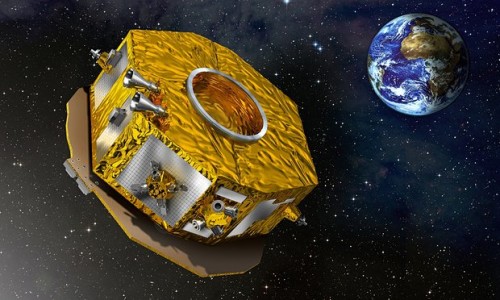
Flying high: LISA Pathfinder has overcome a major hurdle. (Courtesy: ESA)
By Hamish Johnston
2016 is shaping up to be a bumper year for physicists trying to detect gravitational waves. In February the LIGO collaboration announced the first ever direct detection of gravitational waves using two kilometre-sized detectors in the US.
Now, it looks like an even bigger detector will get permission to launch. Researchers working on the LISA Pathfinder space mission have just announced that they were able to isolate a 2 kg test mass at a special “Lagrangian point” between the Earth and the Sun. This is important because the planned LISA gravitational-wave observatory will use test masses located at three points in space (each separated by about one million kilometres) as the basis for a huge detector.
LISA Pathfinder was launched in December 2015 by the European Space Agency with the aim of showing that it is possible to put a test mass at a Lagrangian point, while shielding it from solar radiation and other external influences that could jostle it about. No jostling is allowed because LISA will use lasers to measure the distances between its three masses to very high precision. Gravitational waves – ripples in space–time – will be revealed by tiny displacements of the masses, which occur when a wave passes through the solar system.
The LISA Pathfinder test mass is floating inside a shell-like spacecraft, which monitors the relative motion of the mass. An array of thrusters is used to keep the shell in the correct position relative to the mass, preventing the mass from banging into the inside wall of the shell.
The motion of the test mass is monitored using a second mass located about 33 cm away inside the spacecraft. In essence, this is a much shorter-scale version of LISA, with laser light bouncing between the two masses used to measure their relative motion. The Pathfinder team found that the jostling of the two masses corresponded to accelerations that are about 10–16 g, where g is the acceleration due to Earth’s gravity.
This is tens of thousands of times smaller than what could be achieved on Earth and also much better than the minimum requirement for LISA to be a success.
“The measurements have exceeded our most optimistic expectations,” says team member Paul McNamara. “We reached the level of precision originally required for LISA Pathfinder within the first day, and so we spent the following weeks improving the results by a factor of five.”
So it’s looking very likely that LISA will go ahead as planned in 2034. It will search for gravitational waves that have much lower frequencies than those that can be detected by LIGO. These include signals from binary stars in our galaxy as well as distant supermassive black holes.
The team has described its measurements in a paper in Physical Review Letters.
Trackback: Blog - physicsworld.com